Common Gymnastics Injuries

Gymnastics is a physically demanding sport that requires strength, flexibility, and coordination. However, this demanding nature also makes gymnasts susceptible to a range of injuries. The most common gymnastics injuries affect the wrists, ankles, knees, and shoulders.
Gymnastics injuries – Wrist injuries are among the most prevalent in gymnastics. These injuries can range from sprains and strains to fractures and dislocations. The repetitive use of the wrists during landings and other gymnastic maneuvers can put excessive stress on the wrist joints, leading to pain and discomfort. Additionally, gymnasts who perform on uneven bars are particularly prone to wrist injuries due to the high impact forces involved in this event.
Gymnastics injuries are common, especially among competitive athletes. The men’s gymnastics team consisting of skilled gymnasts often endure rigorous training and competitions, making them susceptible to various physical ailments. These injuries can range from minor sprains and strains to more severe fractures and dislocations, impacting their performance and overall well-being.
Ankle injuries are another common problem for gymnasts. These injuries can include sprains, strains, and fractures. The high-impact landings and quick changes of direction required in gymnastics can put excessive stress on the ankles, leading to pain and instability. Gymnasts who perform on the balance beam are particularly susceptible to ankle injuries due to the uneven surface and the need for precise foot placement.
Gymnastics is a physically demanding sport that requires athletes to have incredible strength, flexibility, and coordination. As a result, gymnasts are prone to a variety of injuries, including sprains, strains, fractures, and dislocations. The men’s gymnastics olympic trials are a particularly challenging event, as athletes compete for a spot on the Olympic team.
The high level of competition can lead to an increased risk of injuries, so it is important for gymnasts to take precautions to protect themselves from harm.
Knee injuries are also relatively common in gymnastics. These injuries can include sprains, strains, and tears. The repetitive use of the knees during landings and other gymnastic maneuvers can put excessive stress on the knee joints, leading to pain and swelling. Additionally, gymnasts who perform on the vault are particularly prone to knee injuries due to the high impact forces involved in this event.
Shoulder injuries are another common problem for gymnasts. These injuries can include sprains, strains, and dislocations. The repetitive use of the shoulders during gymnastic maneuvers can put excessive stress on the shoulder joints, leading to pain and discomfort. Additionally, gymnasts who perform on the uneven bars are particularly prone to shoulder injuries due to the high impact forces involved in this event.
Risk Factors and Prevention Strategies: Gymnastics Injuries

Gymnastics, a physically demanding sport, poses inherent risks of injuries. Understanding these risks and implementing effective prevention strategies are crucial for gymnasts’ safety and well-being. Key risk factors and practical prevention measures are explored below.
Training intensity, technique, and conditioning play significant roles in injury risk. Excessive training loads, improper technique, and inadequate conditioning can strain the body beyond its limits, leading to injuries.
Warm-Ups, Stretching, and Strength Training
Proper warm-ups, stretching, and strength training are fundamental in injury prevention. Warm-ups prepare the body for activity, reducing the risk of muscle strains and sprains. Stretching enhances flexibility, promoting proper movement patterns and reducing the likelihood of tears. Strength training builds muscle strength and endurance, providing a solid foundation for demanding gymnastic maneuvers.
Rehabilitation and Recovery

Rehabilitation for gymnasts recovering from injuries is a complex and multifaceted process that involves several phases and modalities. The primary goal of rehabilitation is to restore the gymnast’s physical function, reduce pain, and prevent re-injury.
The rehabilitation process typically begins with pain management, which may involve rest, ice, compression, and elevation (RICE). Once the pain is under control, the focus shifts to restoring mobility and range of motion through exercises and stretching. As the gymnast’s mobility improves, strength building exercises are gradually introduced to rebuild muscle strength and endurance.
Role of Physical Therapy
Physical therapy plays a crucial role in the rehabilitation process for gymnasts. Physical therapists assess the gymnast’s injury, develop a personalized rehabilitation plan, and provide guidance and support throughout the recovery journey. They utilize various techniques, including:
- Manual therapy to improve joint mobility and reduce pain
- Exercise prescription to strengthen muscles and restore range of motion
- Modalities such as ultrasound, electrical stimulation, and massage to promote healing and reduce inflammation
Managing Pain and Preventing Re-Injury, Gymnastics injuries
Managing pain during rehabilitation is essential to prevent further injury and promote healing. Gymnasts should follow their doctor’s or physical therapist’s instructions for pain management, which may include:
- Taking over-the-counter pain relievers, such as ibuprofen or acetaminophen
- Applying ice to the injured area
- Resting the injured area
Preventing re-injury is equally important during rehabilitation. Gymnasts should gradually increase their activity level and avoid activities that cause pain or discomfort. They should also follow their physical therapist’s instructions for proper form and technique to minimize the risk of re-injury.